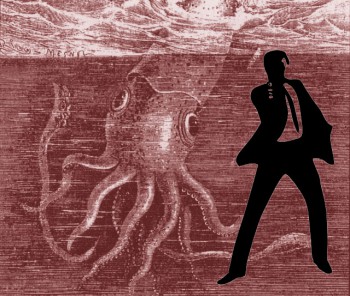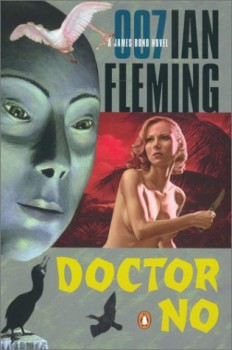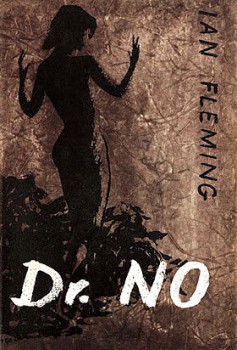James Bond vs. the Giant Squid: Pulp 007 in Doctor No
 Mania, my dear Mister Bond, is as priceless as genius.
Mania, my dear Mister Bond, is as priceless as genius.
Some time ago in the earlier days of the Black Gate blog, E. E. Knight wrote a post about the James Bond movies as classic fantasies. No argument here—especially when I consider things like The Spy Who Loved Me and Bond-drives-an-invisible-car Die Another Day.
However, the conventional wisdom about the divide between the long-running movie franchise and the series of novels and short stories that Ian Fleming wrote in the fifties and sixties is that Fleming is the realistic, grim, down-to-earth Bond, where the movies are outrageous action-filled rides.
I’m a hardcore Bond fan, but unlike most Bondians my age (born into the ‘70s and Roger Moore’s tenure) I grew up on Fleming’s Bond, not cinema’s. I read all the novels for the first time in junior high school, and at that point had only watched perhaps three of the movies. I ended up approaching the film series from the perspective of a Fleming Purist. This doesn’t mean I flip out when anything un-Fleming occurs in the movies—for Apollo’s sake, I actually get a kick out of the Space Opera/Chuck Jones cartoon called Moonraker—but it does mean I have a very different lens on than film series than even most serious Bond fans.
And here’s something I’ve learned over the years from watching the films series develop and tracing the history of the earlier movies (Goldfinger is my favorite of the movies, in case you’re interested): Fleming ain’t realistic. His novels are extremely romanticized views of espionage life, and were thought so at the time. Read John le Carré’s extraordinary The Spy Who Came in From the Cold, meant as an answer to Fleming’s spy-romances, and you’ll immediately see what flights of fantasy Fleming really took with his super-spy. Compared to many of the movies, the novels Casino Royale and From Russia, With Love seem relatively believable, but they are still escapist romances.
Here’s the key difference between the escapism of the films and the books: The movies are fantasies. The novels are pulp adventure—almost literally so.
Reading extensively in the pulps years after I was a confirmed Fleming-nut made me realize that the 007 novels owe a huge debt to the hero pulps of the 1930s, as well as the adventure and hard-boiled detective magazines. Quick examples: Live and Let Die is about a tropical hunt for a pirate’s sunken treasure, and the villain puts Bond in a death trap where he plans to drag 007 over coral and have sharks chew him up. Moonraker’s adversary is a crazed German planning to drop a bomb on London that will destroy it. (The Spider fought many men like Hugo Drax.) Thunderball stars a secret evil organization that wants to hold the western world for ransom. (Again, the Spider faced many SPECTRE wanna-bees in his time, as did Doc Savage.) And You Only Live Twice has a murderous castle built over an exploding magma geyser and which contains a garden filled with the most poisonous plants and animals in the world.
Then there’s 1958’s Doctor No, which is the true the template for the Bond franchise in all media that followed. Doctor No is an outright hero pulp adventure with a few adaptations for an established main character and the political concerns of it decade.
(Caution: I’m really going to spoil the hell out of this. Although I think you could know the whole plot and still love the book. I’ve read it perhaps four times, and it keeps getting better.)
 Doctor No (the movie and U.K. printing are titled Dr. No, but I’m using the longer U.S. title to separate book and film) is easily the most fantasy-themed of any of the Bond novels. A good case could be made for You Only Live Twice as the strangest novel, but it’s strange in a hallucinatory, allegorical “voyage to Hell” way. Doctor No is simply crazy pulp madness; the plot is outrageous, the devices ludicrous, and the villain a pure melodramatic maniac whom Doc Savage might have combated. How over-the-top did Fleming go with this novel? Two words:
Doctor No (the movie and U.K. printing are titled Dr. No, but I’m using the longer U.S. title to separate book and film) is easily the most fantasy-themed of any of the Bond novels. A good case could be made for You Only Live Twice as the strangest novel, but it’s strange in a hallucinatory, allegorical “voyage to Hell” way. Doctor No is simply crazy pulp madness; the plot is outrageous, the devices ludicrous, and the villain a pure melodramatic maniac whom Doc Savage might have combated. How over-the-top did Fleming go with this novel? Two words:
Giant. Squid.
Yep, there is a giant squid in Doctor No. Don’t go back to your DVD copy of the movie and hunt through the chapter stops to see if an enormous cephalopod appears in it and you just forgot about it because you were—depending on gender and orientation—thinking too much about either Ursula Andress or Sean Connery. I assure you, there is no squid in Terence Young’s movie. Only the book has James Bond facing a giant monster.
Yes, James Bond and a giant monster. The “monster” is a real animal, but it’s still a forty-foot freakin’ mollusk, and that counts as a monster in my book.
Doctor No also contains a killer centipede, a flame-throwing tractor disguised as a dragon, a villain with mechanical claw hands and his heart on the wrong side of his body, death-by-crabs, and an obstacle course of pain involving burning, electrocution, and waves of spiders. The villain plans to ruin missile launches from his tropical island base, and the hero kills him by dumping a pyramid of guano on him. Doctor No is completely bonkers. It’s a Doc Savage novel set in the 1950s with a handsome and cruel British intelligence agent as the star. A bit of Cold War politics and steamier sex (Honeychile Rider emerges on the beach in the nude, something the movie certainly couldn’t have done), but the gadgetry and “Yellow Menace” villainy are all pure pulp magazines circa 1930s. Norvell Page would’ve been proud to write this plot, as long as he got to include a gratuitous aerial dogfight.
Amusingly, the mission Bond is sent on at the beginning—basically, go find out why some station chief in Jamaica ran off with his secretary—is a boring one that the agent finds insulting. (“M couldn’t bear his men to have an easy time. In a way Bond felt sure he was being sent on this cushy assignment to humiliate him. The old bastard.”) Readers are already ahead of Bond on this, since the opening chapter, one of the best cold-opens for any 007 novel, shows us the mysterious double murder-arson that is the true fate of the station chief and his pretty secretary. Bond, thinking he’s off to get some sun and boredom, ends up facing a Diabolical Madman out to screw up the western missile defense system. And he owns a pet giant squid!
Doctor Julius No, one of the author’s most wonderful villain creations alongside Auric Goldfinger and Sir Hugo Drax, is essentially Fu-Manchu. And Yellow Claw and Shiwan Khan and many other “Yellow Peril” baddies who populated the pages of the pulp magazines. It seems that the Shadow was going up against one of these Asian no-gooders—often called in the parlance of the day “Celestials”—every other issue. Doctor No is “the only son of a German Methodist missionary and a Chinese girl of good family,” who joined the Tongs. He stole from them, and was executed with a shot to the heart. However, because Doctor No’s heart is literally in the wrong place (“I am the one man in a million who has his heart on the right side of his body.”) he survived and set about on a career as a free-agent, building up his island empire in the Caribbean and working with the Russians to wreak havoc on U.S. guided missiles . . . although he is willing to entertain offers from any other world power. He has also developed a love of inflicting pain to how much the human body can endure—hence, the crazy obstacle course of death that he puts Bond through, which concludes with . . . yes, a giant squid.
The bad doctor is gifted with some delightfully mustache-twirling speeches:
“You are right, Mister Bond. That is just what I am, a maniac. All the greatest men are maniacs. They are possessed by a mania which drives them forward towards their goal. The great scientists, the artists, the philosophers, the religious leaders—all maniacs. What else but a blind singleness of purpose could have given focus to their genius, would have kept them in the groove of their purpose? Mania, my dear Mister Bond, is as priceless as genius. Dissipation of energy, fragmentation of vision, loss of momentum, the lack of follow-through—these are the vices of the herd. . . . I do not possess these vices. I am, as you correctly say, a maniac—a maniac with, Mister Bond, with a mania for power. That . . . is the meaning of my life. That is why I am here. That is why you are here. That is why here exists.”
All right, madman! Keep “in the groove”!
 By the close of the novel, Fleming has built the tension and action at such a fine pitch that “nail-biter” doesn’t even cover it. Doctor No is one of the most exciting novels I’ve ever read, and each time I read it, I still rip through the second half of the book in one sitting, audibly cheering Bond as he battles through amazing adversity to save the day and choke the villain in heaps of bird-excrement. Fleming’s writing is always superb, even in slower moving books like Goldfinger and The Spy Who Loved Me, but he’s in fury mode here and it’s beautiful. He’s ferocious even when he slows down to a literal crawl: the centipede scene is one of finest bits the author ever wrote, a masterpiece of tension.
By the close of the novel, Fleming has built the tension and action at such a fine pitch that “nail-biter” doesn’t even cover it. Doctor No is one of the most exciting novels I’ve ever read, and each time I read it, I still rip through the second half of the book in one sitting, audibly cheering Bond as he battles through amazing adversity to save the day and choke the villain in heaps of bird-excrement. Fleming’s writing is always superb, even in slower moving books like Goldfinger and The Spy Who Loved Me, but he’s in fury mode here and it’s beautiful. He’s ferocious even when he slows down to a literal crawl: the centipede scene is one of finest bits the author ever wrote, a masterpiece of tension.
Doctor No has both the pace and the elements of the pulps; to me it’s proof that Fleming had experience, either first- or second-hand with the American story magazines. (And he did read Sax Rohmer in college.) Fleming’s interpretation of the pulp legacy ended up as one of the guiding forces for adventure stories in all media, from when Bond hit big in the early ‘60s up to . . . well, today and beyond.
Except in the Bond movie series itself. With the release of Quantum of Solace, the Bond film producers seems to feel that only with imitation Jason Bourne beat ‘em-up grittiness, where Bond shoots and punches everybody he meets, can they get audiences to watch. The series is currently in limbo due to the legal tangle around MGM, so I advise the producers to think about this: Yes, Fleming’s novels are more restrained than most of the movies, but they are still fantasies. Look at Doctor No. A classic Fleming Bond novel, and it’s insane. Here is your model for your next film, whoever plays Bond. (I think with the delay that Daniel Craig will opt out, like Timothy Dalton did.) Study the contents of this novel . . . it’s fun, deadly, hurls constant surprises at the reader, ratchets up the tension until it explodes in the finale, features an improbable villain who gives cackling philosophical speeches, stars a James Bond who is a lethally handsome superhero . . . and it has a giant goddamn squid. That’s what I want to see!
last year i found a copy of Dr. No and Casino Royale for 16 cents each. later i got my wisdom teech pulled and read them both then. i acutally enjoyed casino royale better. ps the only bonb movies i’ve seen are Goldfinger and Diamonds are forever.
I distinctly remember a scene with Sean Connery in a tank with a giant squid. Was it in the trailer for Dr. No and edited out of the movie or was it put into a different Bond movie. If you know, please email me at wallferg@juno.com.
Thank you in advance
You are probably remembering footage from Thunderball with Connery in a tank with sharks. (He was separated from them by glass.) The squid was never in any of the drafts of Dr. No and EON never considered it because of the budget. They almost didn’t have money to shoot Dr. No’s laboratory set at the end and had to beg some extra funds from UA to shoot it.